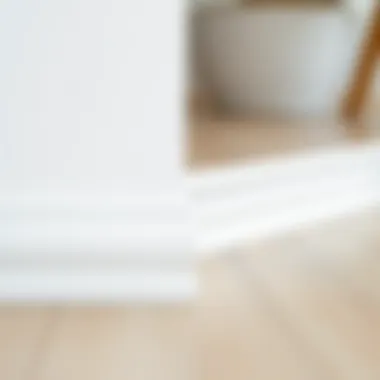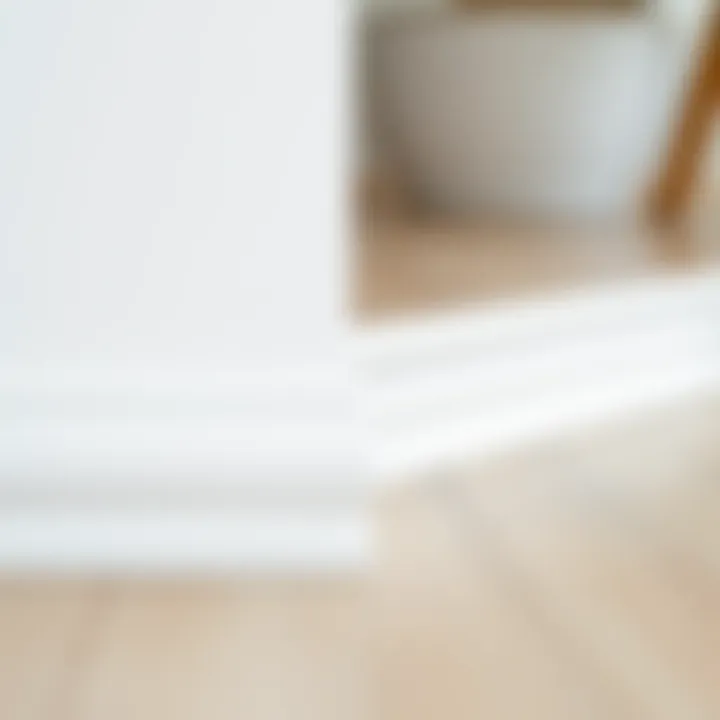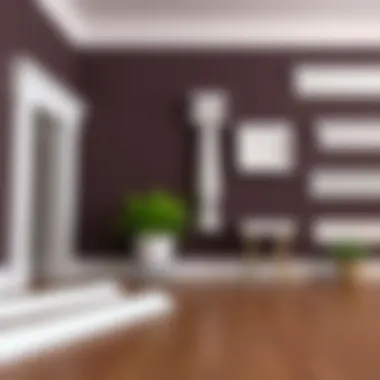Choosing Lowes White Floor Trim for Your Home


Intro
When it comes to elevating the aesthetic appeal of a home, few elements hold as much power as trim. This often-overlooked accent can profoundly transform an interior space, especially when it’s done right. Among the choices available, Lowes white floor trim stands out as a versatile and stylish option, fitting seamlessly into a variety of design styles. This article serves as a comprehensive guide, aimed at guiding homeowners, designers, and DIY enthusiasts through the nuances of selecting, installing, and preserving this critical component of home decor.
The significance of white floor trim transcends mere appearance; it serves both functional and decorative roles. As a foundational element, trim defines spaces, creates visual flow, and accents flooring. Choosing the right trim can turn a simple room into a stunning showcase of style and sophistication. Therefore, understanding the variety of available styles, materials, and installation techniques is pivotal for anyone looking to enhance their home with Lowes white floor trim.
In the subsequent sections, we delve into furniture design styles that complement white trim, practical tips for homeowners to ease the selection process, and much more. Whether you’re aiming for a sleek modern look or a more traditional feel, knowledge is key in making informed decisions.
Furniture Design Styles
When integrating Lowes white floor trim into your home, understanding the various furniture design styles can help you achieve harmony and coherence in your decor. A well-chosen trim can serve as a bridge, tying together disparate elements within a space.
Overview of Popular Styles
Among the most popular furniture design styles that pair well with white floor trim are:
- Modern: Characterized by clean lines and minimal decor, modern designs shine when accented with white trim. The contrast can elevate the sophistication of a space.
- Traditional: This style often combines classic elements with a refined sensibility. White trim adds a touch of elegance to traditional furnishings.
- Industrial: Embracing raw materials and a rugged aesthetic, industrial spaces can benefit from the crispness of white trim, providing a fresh counterbalance to rough textures.
- Farmhouse: Featuring rustic charm, the farmhouse style can incorporate white floor trim to enhance its warmth, creating a homey feel.
- Scandinavian: Defined by simplicity and functionality, this style often uses white accents to maintain brightness in space, making white trim a natural fit.
How to Mix and Match Styles
Combining different design styles has become increasingly popular. The key is to maintain a balance to avoid a chaotic look. Here are some tips for mixing styles while using Lowes white floor trim effectively:
- Choose a Dominant Style: Start by selecting a main style to provide direction.
- Use Trim as a Cohesive Element: Leverage white trim to tie different styles together, providing continuity across spaces.
- Balance Colors and Textures: When mixing styles, ensure that the colors and textures balance; trim can help soften harsh transitions.
- Accent with Furniture: Consider accent furniture pieces that reflect the different styles to avoid overpowering the trim.
- Harmonize Patterns: Use similar patterns or palettes in textiles to unify various design elements without compromising individual style integrity.
By understanding and playing with design styles, you can create a space that's uniquely yours while using trim to enhance the overall aesthetic.
Practical Tips for Homeowners
Selecting and installing Lowes white floor trim is not just about appearance; there are practical aspects to consider as well. Here are some essentials every homeowner should keep in mind to ensure a smooth process.
Essential Buying Tips
- Quality Matters: Always inspect the material for durability. High-quality options may come at a higher price but offer longevity.
- Consider the Profile: Trim profiles come in various shapes and sizes; pick one that complements the furnishings and architecture of your home.
- Measure Precisely: Before purchasing, ensure accurate measurements to avoid costly mistakes. Getting this right saves not only time but also money.
- Ask for Samples: Don’t hesitate to ask for sample pieces to see how the trim looks against your wall paint and flooring in different lighting.
Maintenance and Care Guidelines
Once you’ve installed your Lowes white floor trim, proper care ensures its longevity:
- Regular Cleaning: Dust and dirt can accumulate. A simple wipe with a damp cloth can maintain luster.
- Avoid Harsh Chemicals: When cleaning, steer clear of abrasive cleaners that can damage the finish.
- Inspect Periodically: Check for signs of wear or damage and address them promptly to avoid bigger issues.
- Touch Up Paint: If you notice chips or scratches, consider using touch-up paint to keep your trim looking fresh.
Intro to White Floor Trim
When one thinks of home decor, the bigger picture often comes to mind: paint colors, furniture styles, and perhaps the choice of flooring. Yet, sitting quietly at the edge of this elaborate framework is the humble floor trim. This article explores white floor trim from Lowes, shedding light on its significance in creating not just an aesthetic appeal, but also a sense of cohesion and closure in interior spaces.
Defining Floor Trim
Floor trim, often referred to as moldings or baseboards, serves a crucial function in finishing the transition between flooring and walls. It's not mere decoration; it assists in hiding gaps, protecting walls from scuffs, and providing a finished appearance that visually frames the room. Think of it as the icing on the cake—it may not be the main dish, but it definitely adds the final touch that elevates everything else.
In a practical sense, floor trim comes in various styles and materials, each suited for different atmospheres and themes. From simple squared profiles that evoke a modern look to intricate designs that offer a more traditional flair, the selection is vast. Importantly, understanding this definition lays the groundwork for appreciating the role trim plays in a well-thought-out design scheme.
Importance of Trim in Interior Design
The role of trim goes well beyond simple functionality; it enables householders to manifest their personal flair through distinct design choices. Effective use of trim can significantly uplift the ambiance of a space. In fact, trimming can create illusions of height and space, drawing the eye upward or giving the illusion of larger rooms when applied thoughtfully. For instance, fitting taller baseboards in a room with high ceilings may enhance that feeling of spaciousness while also introducing a sense of grandeur.
In the world of design, trim can also act as a connecting element, harmonizing different materials and colors at play within the same room. For example, if your walls are painted a soft gray, pairing that with a white trim from Lowes makes the walls pop, creating a pleasing contrast without overwhelming the senses.
Furthermore, a strategically chosen trim style helps in narrating the story of a home. In traditional spaces, one might opt for ornate models that speak to classic tastes, while a contemporary setting might favor sleek, minimalist lines.
"It's the details that make the design come alive; neglecting them can undermine a well-planned space."
Ultimately, understanding the essence of white floor trim is to realize its dual role as both a practical solution and an artistic choice. When considering how to elevate your home, remember that the trim is not merely a finishing touch—it's a design fundamental that provides both character and continuity across the space.
By taking the time to select the right white floor trim, it's likely that you'll find your interior vision coming alive in ways that truly captivate the eye and enhance your living experience.
In our subsequent sections, we will delve into the specifics of Lowes as a reliable source for this vital component, exploring material compositions, design styles, installation techniques, and the maintenance necessary for keeping your white floor trim in prime condition.


Lowes: A Trusted Source
When it comes to home improvement, finding a reliable source for materials is as vital as choosing the right styles. Lowe's has established itself as a go-to destination for homeowners and professionals alike, offering a solid foundation for any home renovation project. Their extensive line of white floor trim stands out not just for variety but also for quality, ensuring that customers are equipped to make aesthetic as well as functional choices.
The Importance of Lowes as a Source
Lowes is more than just a retail giant; it represents a culmination of expertise in home improvement. Customers can browse through an extensive selection of products, often finding everything they need under one roof. The tactile experience of seeing and feeling the materials before making a purchase cannot be overstated—it's a crucial part of the decision-making process. Moreover, the knowledgeable staff can provide insights tailored to individual projects, addressing specific concerns about durability or style suitability.
The Lowes Experience
Stepping into a Lowe's store is often just the beginning of the journey. It's designed to be an experience that immerses customers into the world of home improvement. The layout is intuitive and organized, allowing easy navigation through various departments. From paint to plumbing, customers can explore a vast selection with the ease of a Sunday stroll.
One can’t ignore the power of digital tools as well; Lowe's has invested in technology that enhances the shopper experience. From virtual reality design tools to extensive online resources, Lowe's meets customers where they are. Whether visiting a brick-and-mortar store or browsing online, the experience is geared towards convenience and informed decision-making.
"Shopping at Lowe's goes beyond just purchasing items; it’s about a journey—a path of inspirations and solutions for your home."
Customer Focus and Product Range
Lowe's places a heavy emphasis on customer satisfaction, tailoring its offerings to meet diverse needs. Their commitment to providing options that cater to various price points makes it a platform that suits both budget-conscious individuals and those seeking premium materials.
- Diversity in Selections: The white floor trim available includes options made from different materials—MDF, wood, and vinyl. Each type has its own set of advantages, allowing customers to select what best fits their aesthetic preference and project requirements.
- Informed Choices: By offering clear labeling on products and informative signage throughout the store, Lowe's empowers customers to understand what they are purchasing. Understanding terminology can help in selecting products that will endure over time.
Their robust online presence further enables customers to research products before stepping into the store. With customer reviews and comparison tools available, one can often glean just about all the necessary information without needing to ask a single question.
Material Composition
In the realm of interior design, material composition stands as a fundamental aspect woven into the very fabric of aesthetics and functionality. The choice of material not only shapes the look of the space but also serves practical purposes. When selecting Lowes white floor trim, understanding these materials provides crucial guidance, ensuring that decisions made echo the desired style and maintain durability over time.
Types of Materials Used
MDF
MDF, or Medium Density Fiberboard, is a popular choice when it comes to floor trim. One of its standout characteristics is its smooth surface that lends itself well to painting, allowing for a flawless and polished finish. This makes it a go-to for those looking to match their trim with existing decor. MDF's dense construction allows it to resist warping more effectively than solid wood. However, it's worth noting that while MDF is generally less expensive, it can be prone to water damage. In spaces like kitchens or bathrooms, extra caution is key to prolonging its lifespan.
Unique Feature: MDF is easily shaped and molded, providing versatility in design. Its affordability paired with aesthetic appeal makes it a favorite among many homeowners.
Wood
When thinking of trim, solid wood is often the first to come to mind. This natural material boasts a certain warmth and richness that synthetic options struggle to match. The key characteristic of wood is its longevity; with proper care, it can last generations, developing a lovely patina over time. However, solid wood can come with its challenges. It is more susceptible to changes in humidity and temperature. This could lead to warping or cracking if not maintained properly.
Unique Feature: Each piece of wood has its unique grain pattern, giving a timeless and elegant feel to any space it adorns. Selecting the right finish can enhance its natural beauty.
Vinyl
Vinyl floor trim is gaining popularity for its durability and water-resistant qualities. Particularly in high-moisture areas, such as bathrooms, vinyl stands out as an ideal choice. Easy to install and maintain, this material can mimic the look of wood without the complicated upkeep. A defining characteristic is its affordability, appealing to budget-conscious homeowners. Nonetheless, it’s important to note that vinyl may not have the same aesthetic appeal as wood or MDF. However, with advanced printing technology, many options now come close to replicating natural textures and colors.
Unique Feature: Vinyl is lightweight and flexible, allowing for easy installation even in less traditional spaces.
Benefits of Choosing Quality Materials
Opting for quality materials goes beyond the initial purchase price; it's about the longevity and appearance of your space. Here are some advantages:
- Durability: Quality materials often withstand the test of time, reducing the likelihood of future replacements.
- Maintenance Ease: High-quality trims make cleaning and upkeep simpler, avoiding the hassle of constant repairs.
- Aesthetic Value: A visually appealing trim can enhance the overall appearance of a room, adding value to your property.
"Investing in quality materials often pays off in the long run, blending beauty with practicality." By selecting the right materials for your Lowes white floor trim, you pave a pathway toward a stunning and lasting interior that speaks to both style and functionality.
Design Styles of White Floor Trim
In the realm of interior design, white floor trim serves as more than just a mere border; it is an essential element that establishes a room's character. Choosing the right design style can emphasize the aesthetic appeal of your space, providing an impactful finishing touch that ties everything together. All the while, effective trim choices reflect a cohesive design vision.
Different styles of white floor trim address various tastes and preferences, helping to harmonize your decor and setting the mood. Below, we will delve into specific categories, comparing traditional and modern aesthetics, exploring minimalist and contemporary trends, and discussing craftsman and rustic elements. Each section will highlight how these styles contribute to the overall narrative of a room.
Traditional vs. Modern Aesthetics
When it comes to trim, traditional styles often echo the elegance of yesteryears. Think of intricate moldings and thicker profiles that harken back to classic craftsmanship. These trims typically feature detailed designs such as flutes or bevels, bringing a timeless charm that works beautifully in older homes or spaces designed to emulate historical styling.


On the other hand, modern aesthetics lean towards simplicity. Clean lines and uniform shapes characterize modern white floor trim, often opting for a sleeker, understated look. These designs enhance the spacious feel of contemporary homes and help create a seamless flow, opting for functionality coupled with minimalism. Importantly, streamlining trim can also draw attention to bolder wall colors or textured flooring without outshining them.
Ultimately, the choice between traditional and modern comes down to personal preference, but it is crucial to ensure the trim style aligns with the overall design narrative of your home.
Minimalist and Contemporary Trends
Minimalism has become a buzzword in recent years, and for good reason. A minimalist approach emphasizes the beauty of simplicity. With white floor trim, this translates to designs that are slim and uncomplicated. Choosing flat profiles or very subtle decorative touches can create a calming effect, easily contributing to the sense of peace associated with minimalist spaces.
Incorporating contemporary trends, such as elongated baseboards, can further elevate your space. This design trend not only makes a room feel taller but also integrates seamlessly into the overall aesthetic, allowing decorative elements to take center stage. When paired with a light color palette, minimalist white trim can transform an ordinary space to feel open and airy.
Craftsman and Rustic Elements
Craftsman-style trim speaks to those who appreciate organic materials and craftsmanship. This design often features characteristic details, such as exposed joints and simple, earthy lines. White floor trim in a craftsman style usually embodies a chiseled quality, evoking an artisanal touch that resonates strongly with nature lovers. These details can soften modern elements and create warmth in spaces that may feel too sterile or stark.
Rustic elements, similarly, focus on natural materials and rugged textures. In the context of white floor trim, rustic designs can include distressed finishes or reclaimed wood appearances that impart a sense of history and nostalgia. By incorporating such trims, you can create a grounded atmosphere, offering balance to chic or contemporary touches throughout your decor.
Choosing the Right Trim for Your Space
Selecting the appropriate trim for your home is akin to choosing the right accessories for an outfit; without the right fit, even the most well-designed space may fall flat. White floor trim serves not just a functional purpose, but is a key design element that breathes life into a room. It can connect various aesthetic components, complementing or enhancing existing decor.
When contemplating floor trim, there are several elements to ponder: the sizing and scale, as well as the color coordination with walls and floors. Both aspects can significantly influence your space's ambiance. The right trim does more than delineate; it can also visually elevate ceilings, elongate walls, and blend different areas into a cohesive whole.
Sizing and Scale Considerations
Think of sizing as the backbone of your trim design. If a trim is too small, it risks disappearing into the space, while one that’s too large can overwhelm a room. Here are a few critical considerations:
- Room Dimensions: Measure the height and width of your space. Taller rooms can handle wider and taller trim, while smaller spaces often benefit from more streamlined profiles.
- Style of Your Home: Traditional homes tend to look best with more substantial, ornate trims, while minimalist designs usually call for sleek, understated profiles.
- Functional Areas: In areas subject to wear and tear, such as hallways and staircases, robustness should be prioritized; heavier trims might serve better in such high-traffic zones.
In essence, finding harmony in size ensures that the trim enhances without overshadowing the elements of your space.
Color Coordination with Walls and Floors
The relationship between your trim and the surrounding colors is critical. White trim, by nature, offers versatility; however, its effectiveness hinges on how it complements other elements in the room. Here’s where color coordination comes into play:
- Contrast vs. Blend: If your walls are of a soft color, a bright white trim can provide a crisp contrast that accentuates architectural features. On the other hand, for walls already suffused with white, consider slightly tinted or warmer whites for your trim. This subtle shift can add depth.
- Textures Matter: If walls are heavily textured, a smooth white trim can introduce a sophisticated balance, while textured trims with a white finish can add visual interest.
- Flooring Effects: Keep in mind how the trim contrasts or complements your flooring. Dark wood floors paired with white trim can create a striking effect, while lighter flooring might require a different approach to maintain a seamless look.
Choosing the right color can transform a room entirely. The art lies in the details, where thoughtful coordination creates an aesthetic that feels deliberate and curated.
The meticulous approach to sizing and color coordination can make or break the interior experience. It ensures that every inch of your space tells your story while keeping it functional and appealing. Therefore, taking the time to consider these details thoughtfully can cement a floor trim's role as a key player in your design narrative.
Installation Techniques
Understanding the proper installation techniques for white floor trim can make all the difference in achieving a polished and professional look in your interior space. This section delves into the necessary preparations, the essential tools, and a step-by-step guide to ensure that your trim not only looks good but is also securely and effectively placed. For designers, homeowners, and DIY enthusiasts alike, mastering these installation techniques is crucial in transforming a room from ordinary to extraordinary.
Preparation Steps Before Installation
Before diving into the actual installation, taking the time to prepare is key. Preparation can save time and headaches down the line. Here are some steps to consider:
- Select Your Trim: Choose the white trim that suits your design. Lowes offers a variety of styles and materials, so your first task is often deciding what works for your space.
- Measure Twice, Cut Once: Accurate measurements cannot be overstated. Measure the length of the walls where the trim will go, accounting for corners and miter cuts.
- Clear the Work Area: Free the area of furniture and any potential obstructions. This will give you a safer space to work in.
- Profile the Floor Surface: Ensure your floor is level and clean to avoid gaps or uneven placement of the trim. If the subfloor is uneven, consider using shims during installation.
Taking these steps provides a solid foundation for a smooth installation process.
Tools and Materials Needed
Having the right tools and materials handy will simplify the installation experience:
- Tools:
- Materials:
- Miter Saw: Essential for cutting angles to achieve clean and precise fits.
- Nail Gun or Hammer: A nail gun saves time and effort compared to hammering nails manually.
- Tape Measure: Vital for accurate measurements.
- Level: To ensure that your trim is properly aligned.
- Caulk Gun: For sealing gaps and achieving a professional finish.
- White floor trim from Lowes (MDF, wood, or vinyl, depending on your choice).
- Wood Glue: Provides additional support during installation.
- Paint or Stain (if necessary): To color-match or finish your trim.
- Caulk: For filling any gaps and ensuring a clean finish.
Gathering these resources before you start will keep everything running smoothly.


Step-by-Step Installation Guide
Getting down to business, follow this step-by-step guide for installing white floor trim:
- Cut the Trim: Using your miter saw, cut the trim pieces to length. Start with the long walls, then move to the shorter ones. Remember to make miter cuts for corners.
- Dry Fit: Before nailing anything down, dry fit all pieces to ensure they fit well together. This is the time to make any adjustments.
- Attach to Wall: Start by attaching the first piece of trim to your wall. Use your nail gun (or hammer if you're going old school) to secure it. Make sure it is level.
- Continue Installation: Work your way around the room, attaching each piece of trim. When you reach corners, miter those cuts for a neat appearance.
- Fill Gaps and Holes: Once all trim is installed, fill any exposed nail holes with wood filler. Use caulk at the top of the trim where it meets the wall for a seamless look.
- Finish Touches: Finally, paint or stain your trim as necessary, and clean the area to complete your project.
"A well-installed trim is not just a frame; it is an integral part of the room's design that binds together walls, floors, and decor."
By following these installation techniques, you lay the groundwork for an aesthetically pleasing and functional space. The right preparation, tools, and systematic approach can transform both the look and feel of any room.
Maintenance of White Floor Trim
Maintaining white floor trim is an often underestimated aspect of keeping your home looking polished and well-cared for. While the initial installation might garner all the attention, it's the ongoing upkeep that truly keeps the aesthetic intact. Over time, dirt, scuffs, and other forms of wear can accumulate, making once-pristine trim appear dingy and neglected. Understanding how to effectively maintain this element can elevate not just the trim itself, but the overall impression of your interior space.
Regular maintenance ensures that your white trim continues to contribute to the elegance of your design without becoming an eyesore. A little knowledge and effort can go a long way. With that in mind, let's break down some advice for keeping your white floor trim in tip-top shape.
Cleaning and Care Recommendations
To keep your white floor trim gleaming, regular cleaning is essential. Here are some practical recommendations:
- Dust often: Use a soft cloth or a duster to remove dust and dirt regularly. Duster attachments can reach nooks where grime tends to linger.
- Gentle cleaning solutions: Opt for mild soap solutions or commercial cleaners specifically designed for white trim. Avoid harsh chemicals that might yellow the finish.
- Microfiber cloths: These are excellent for both cleaning and polishing. They are less likely to scratch the surface than other fabrics.
- Spot cleaning: For stubborn stains, a soft brush with a little warm soapy water can do wonders. Dip the brush lightly in the mixture, scrub gently, and dry the area thoroughly after.
In addition to the cleaning routines, consider using furniture polish every couple of months to maintain that shiny look and protective layer against future grime.
"Regular maintenance is like a stitch in time; it saves nine! Keeping up with small tasks prevents larger problems."
Addressing Wear and Tear
Over time, it's natural for white floor trim to show signs of wear. Addressing these issues promptly can extend the life of your trim and keep your space looking sharp:
- Inspect regularly: Schedule a monthly inspection to look for scuffs, chips, or scratches. Identifying issues early allows you to manage them before they become extensive repairs.
- Touch-up paint: Keep a small can of matching trim paint on hand for quick fixes. This can be invaluable for chips or scratches that suddenly catch your eye. A quick brushover can make a world of difference.
- Consider caulking: If there are visible gaps between the trim and floor, it can detract from your decor. Using a paintable caulk can create a streamlined look while also preventing moisture from getting underneath.
- Replace when necessary: Sometimes, wear may become too pronounced. If a section of your trim is beyond repair, swapping it out might be the best option to maintain overall aesthetics.
Taking action against wear and tear not only preserves visual appeal but protects your investment in the décor. Adopting a proactive mindset in maintaining your white floor trim can yield long-term rewards.
Trend Insights
Keeping an eye on current trends in trim design is vital for homeowners, designers, and DIY enthusiasts. It allows for fresh ideas that can breathe new life into spaces. The right trim does more than just frame a room; it can create a flow, highlight a theme, and add character to an interior. Therefore, it’s crucial to stay informed about evolving trends and adapt accordingly.
"Trends can be like waves; you either learn to ride them, or you get washed away."
Current Trends in Trim Design
In today's market, a few noteworthy trends are steering the direction of trim design. With homeowners seeking to personalize their spaces, the following elements have gained traction:
- Organic Materials: Push for sustainability resonates with many. More people choose trim made from reclaimed wood or natural products, which bring warmth and authenticity.
- Bold Colors: While white remains a favorite, using colors for trim that accentuate wall hues or flooring choices creates a striking contrast. Using unexpected colors for the trim can redefine traditional approaches.
- Geometric Patterns: Designers are experimenting with shapes beyond the conventional. Vertical or horizontal lines can change the perception of space, adding depth and intrigue.
- Minimalistic Styles: Clean lines and simple profiles cater to the minimalist movement. Many are opting for sleek, flat profiles that bear simplicity yet sophistication.
All of these trends share a common thread: they encourage individual expression. When selecting trim, considering how it reflects personal style becomes increasingly essential.
Predictions for Future Styles
Looking ahead, a few exciting possibilities could emerge in trim design. While it’s hard to predict with certainty, trends usually evolve rather than disappear completely. Some potential directions include:
- Tech-Infused Trim: The rise of smart homes might bring an element of technology into traditional designs. Imagine trim that integrates LED lighting for ambiance—all completely customizable.
- Eco-Friendly Innovations: With increasing attention on sustainability, materials that incorporate recycled products will likely see greater popularity, promoting a more responsible approach to home decor.
- Cultural Fusions: As globalization connects designers and artists worldwide, unique combinations of cultural influences may appear in trim design, leading to eclectic and bold designs that draw inspiration from various heritages.
- Adaptive Trim Systems: Flexible trim systems that can easily adapt to changes in room layouts or decor styles could emerge, allowing DIYers and professionals alike to modify as needed without heavy renovations.
In summary, by keeping abreast of these trends and predictions, those looking into trim options at Lowes can make informed choices that meet not only aesthetic needs but also align with evolving lifestyles.
The End
In wrapping up our exploration of Lowes white floor trim, it's essential to highlight several key points that not only reinforce the significance of this article but also emphasize considerations that can greatly influence one’s decorative choices. The right trim serves both aesthetic and functional purposes, enhancing the overall style of a room while also providing necessary visual boundaries between different surfaces.
Choosing the correct floor trim is not a trivial pursuit. It involves a careful assessment of both personal style and the characteristics of your space. If a homeowner opts for a decorative trim that complements existing architecture, it often results in a more cohesive interior design. On the other hand, a misaligned choice may disrupt the flow of a well-planned room.
Final Thoughts on Selection and Installation
As you consider your selections, keep in mind that white floor trim from Lowes comes in various styles and materials, each offering unique benefits. Whether you lean toward the warmth of natural wood or the sleekness of MDF, understanding how these materials fit in with your home’s current aesthetic will aid significantly in both visual appeal and durability. Installation is another crucial facet. Taking the time to not just measure but also plan out the installation can save you potential headaches down the line. Investing in good quality tools will pay off during the installation process, ensuring that the finish is as professional as possible.
Encouraging Thoughtful Aesthetics
In the grand scheme of home design, trim is often overlooked but can serve as a standout feature when done thoughtfully. The aesthetics of a room can be greatly enhanced by simple choices in trim, reflecting the homeowner's style while also paying homage to the surrounding environment. A well-chosen white floor trim can brighten a room by reflecting light, making smaller spaces feel more expansive. As trends evolve, it's vital to stay abreast of contemporary aesthetics, often favoring clean lines and minimalistic designs, yet not forgetting classic elements that tie in the historical essence of homes.
Ultimately, the journey of selecting and installing Lowes white floor trim transcends mere functionality—it invites design enthusiasts to engage with creativity and express their unique vision for their spaces.















